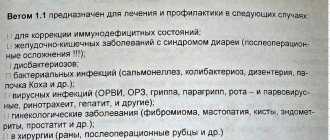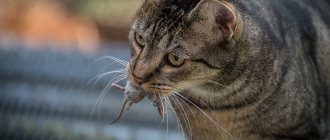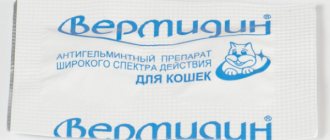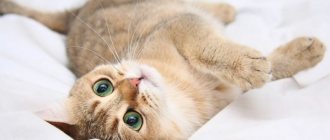Routes of infection
The FCoV coronavirus enters a cat's body orally or nasally if a particle of feces from a sick animal enters its mouth or nose. The virus can remain viable in the external environment for up to 7 days, and in the body of an animal carrier it can survive in “sleep mode” for up to a year until it receives favorable conditions for reproduction.
The disease is most often registered in cats under the age of two years, as well as in individuals older than 10-12 years. Cats kept in large groups are at greatest risk: residents of nurseries and cat shelters. Domestic cats, which have little contact with their relatives, according to statistics, account for less than 10% of cases of the total number of coronavirus gastroenteritis. The risk of human transmission of infection to a domestic cat is small, but still exists. This is possible if feces of an animal sick with coronavirus gastroenteritis gets on the clothes or hands of the cat owner.
Important! A cat sick with coronavirus gastroenteritis cannot infect a kitten through the placenta during its fetal development. But after the birth of kittens, it is recommended to isolate them from their sick mother.
What are the prognosis and prevention?
Forecasts for coronavirus gastroenteritis are not always reassuring.
Much depends on the condition of the animal and its ability to fight the virus. What happens:
- In half of the cases, the cat is cured, although the unpleasant symptoms are difficult to bear. However, after recovery, the virus will be present in the animal’s feces for another nine months.
- Approximately ten percent of all sick animals die. If treatment is not started on time, the virus takes on a different form and causes serious pathologies of internal organs.
- In rare cases, viral gastroenteritis becomes chronic. The cat periodically experiences symptoms of the disease, but it is possible to cope with them at home. However, the pet will be a carrier of the virus all its life.
In most situations, the prognosis is favorable if treatment is started on time and the owner is attentive to the pet. In rare cases, there are animals whose bodies are resistant to viruses, so they are not susceptible to this disease.
Prevention methods
It is possible to avoid the development of gastroenteritis if you adhere to specific rules. It is necessary to adjust the animal’s nutrition and carefully monitor the quality of food.
We recommend: Poisoning a cow with feed, apples, table salt
Rules:
- Be sure to periodically give your cat anti-worm medication;
- Avoid contact between your pet and stray animals to avoid infection;
- If there are several cats living in the house, the trays need to be placed in different places;
- If only a lambing individual is infected with coronavirus, then the kittens are taken from her no later than five weeks from birth;
- Animals carrying the virus should not be near healthy cats;
An attentive owner, if you notice a change in your pet’s behavior, contact a veterinarian. Coronavirus is contagious and dangerous; timely treatment will help save the animal’s life.
Causes
Feline gastroenteritis occurs for the following reasons:
- Traumatic injury when swallowing hard objects - fish bones, small toys.
- Formation of trichobezoars from hairs swallowed during licking. Long-haired cats are primarily affected.
- Sudden change of food.
- Eating food from the hosts’ table - fried, salty, smoked, sweet.
- Mixing dry granulated food with natural products.
- Poisoning by mice caught during deratization with anticoagulants.
- Complications of chronic non-communicable diseases.
- Side effects of medications.
- Contagious diseases of infectious or parasitic etiology.
- Formation of tumors.
Clinical manifestations: symptoms and causes
Symptoms
In the vast majority of cases, the cat experiences a decrease or complete absence of appetite. The animal is weakened and looks depressed.
In addition, the following signs of digestive disorders are also observed:
- Vomiting - sometimes with traces of blood or bile.
- Diarrhea - often also with blood, mucus and waste of undigested food; it can also be with signs of the presence of fat (steatorrhea, or, in other words, fatty feces).
- Abdominal pain - the cat is hunched over and acting restless.
- When palpated, her abdomen is painful and tense.
- With the purulent and hemorrhagic form of gastroenteritis, the temperature may be elevated, and pus and blood are visible in the feces, which themselves have the characteristic appearance of the so-called raspberry jelly. The animal is lethargic, apathetic and inactive.
- Due to frequent vomiting and diarrhea, dehydration can develop, during which the cat loses a lot of weight, its eyes become sunken, and the skin loses its elasticity and, if folded, it will not straighten out immediately.
- The mucous membranes are pale; if the liver is involved in the process, they may also be icteric.
- With coronavirus gastroenteritis, damage to the central nervous system is also possible: the cat may have paralysis, paresis, ataxia and seizures.
Causes
Non-infectious gastroenteritis:
- Incorrect, unbalanced nutrition: feeding low-quality, rough, spicy or too salty food, skipping feedings for no significant reason.
- Binge eating.
- Poisoning with heavy metal salts that may be present in the food.
- Food allergies.
- Side effects of medications that negatively affect the digestive system.
Infectious gastroenteritis:
- Viruses - parvovirus, coronavirus, hepatitis.
- Bacteria - E. coli, salmonella.
- Parasites - worms, isospores, coccidia.
Non-infectious diseases and pathological processes in the body:
- Diseases of the gastrointestinal tract: gastritis, liver disease, pancreatitis, intestinal obstruction.
- Accumulation of hairballs in the stomach or intestines - trichobezoars, which are caused by ingestion of hair during licking.
- Congenital or acquired defects in the structure of the digestive organs.
- Stress.
Important!
One of the most severe and dangerous forms of gastroenteritis is hemorrhagic, which often begins for no apparent reason. Scientists suggest that this disease is of an autoimmune nature, or that it can occur due to infectious diseases.
Symptoms
The FCoV virus, having entered the cat’s body, “nests” on the intestinal mucosa. In the presence of favorable conditions (a decline in the animal's immunity, stress, poor nutrition), the infectious agent begins to multiply rapidly, causing inflammation of the intestinal mucosa, and then the stomach. The secretory and motor functions of the gastrointestinal tract are disrupted, and catarrh of the stomach and intestines develops.
Signs of gastroenteritis in cats are usually quite pronounced and difficult to ignore. This:
- diarrhea,
- vomit,
- poor appetite
- blood and mucus in stool
- in severe cases - elevated temperature.
The animal becomes apathetic, stops grooming itself, and has a dull look. When you try to drink water or eat something, you experience “dry” gagging.
Attention! Often the cat owner mistakes the above symptoms for a common intestinal disorder and tries to cure the pet on his own. This cannot be done: coronavirus gastroenteritis can be fraught with serious consequences. If not properly treated, the relatively harmless FCoV virus can mutate into a highly virulent strain of FIPV that causes peritonitis, often leading to death.
Causes and symptoms of the disease
Why is it possible for a cat to become infected with the coronary gastroenteritis virus? There are several causes and methods of infection. How is the disease transmitted?
Transfer methods:
- Oral or nasal route. The virus enters the animal's body by eating contaminated feces or by inhaling particles from trays. Even a small amount of litter from a sick cat is enough to infect other cats.
- Kittens become infected during the transition from mother's milk to another diet. While the mother feeds the kitten, the baby develops specific antibodies that protect it from various diseases. Later, the kitten’s weak immune system is not yet able to resist gastroenteritis, which becomes the cause of infection.
- A person is not able to infect a cat; the virus is not transmitted to people from sick individuals. Infection is possible from clothing or hands stained with feces.
Gastroenteritis, not caused by viruses, develops for various reasons - overeating, poisoning, allergic reactions and other pathological processes in the digestive system.
An attentive owner always monitors the condition of the pet. The symptoms of any gastroenteritis manifest themselves quite intensely, it is impossible not to notice them.
Signs:
- Decreased appetite or refusal to eat;
- Vomiting, severe diarrhea;
- Lethargic, apathetic state;
- Increased body temperature;
- When trying to eat, the animal attempts to vomit, but without vomiting;
- The abdomen is swollen, tense, painful when palpated;
- The mucous membranes are pale, with liver damage they have an icteric tint;
We recommend: The parrot was poisoned: first aid and treatment, symptoms and consequences
With the development of gastroenteritis, damage to the nerve endings is possible, the cat experiences convulsions and paralysis.
Coronavirus gastroenteritis disease concept
Coronavirus gastroenteritis is a hemorrhagic inflammation of the gastrointestinal tract due to infection of a pet with the FCoV virus. This is a common disease in cats, which is explained by the high probability of infection and the fact that many domestic animals (dogs, pigs) and humans can be carriers of pathogenic microorganisms.
Feline coronavirus under a microscope
Diagnostics
If a cat has symptoms of gastroenteritis, to determine the cause of its development
A history and physical examination are not enough. It is necessary to conduct a number of laboratory and hardware studies. Blood and feces are taken from the animal, the test results of which can reveal problems with other organs that have led to disruption of the gastrointestinal tract. Bacteriological and virological analysis of vomit and gastric lavage may also be required.
One of the informative diagnostic methods is ultrasound, which makes it possible to detect the presence of dynamic intestinal obstruction or foreign objects in the gastrointestinal tract, changes in the structure of its walls. In some cases, to increase the reliability of such an examination, the cat is prescribed an abdominal x-ray.
Diagnosis of gastroenteritis in cats
Many cases of even severe vomiting and diarrhea do not last long, resolve easily and do not require careful diagnosis. Diagnosis is necessary in cats with severe vomiting and diarrhea that have other symptoms, or if their feces and vomit contain blood. Appointed:
- General blood analysis.
- Blood chemistry.
- Determination of the concentration of thyroid hormones (T4) in cats over 6 years of age.
- Analysis for feline leukemia virus and feline immunodeficiency virus.
- Analysis of urine.
- Radiographs of the abdominal cavity.
- Stool analysis.
Is it transmitted to humans?
Coronavirus gastroenteritis is not transmitted from cats to humans. The virus affects only members of the cat family; other animals and humans can be carriers of the infection, spreading it on clothes, hands, and fur, but without getting sick.
Coronavirus gastroenteritis in cats is a deadly disease. If you do not promptly contact a veterinarian to prescribe therapy and ignore suspicious symptoms, it will be very difficult to cure your pet. Severe forms of coronavirus cannot be treated, and 100% of such cases are fatal. To prevent the animal from becoming infected, it is important to follow preventive measures and carefully monitor changes in the cat’s behavior.
Gastroenteritis is an inflammation of the stomach and small intestine, characterized by diarrhea and vomiting, accompanied by intoxication and dehydration. Primary gastroenteritis develops when inedible objects, products unacceptable for the cat’s diet, enter the alimentary tract, as well as a hypersensitive response to individual components of the feed. Secondary pathology occurs as a result of exposure to infectious agents or invasions. Pets of all ages get sick. The disease poses a threat to the cat's life.
Causes of gastroenteritis in cats
Causes of gastroenteritis in cats:
- Consumption of inappropriate food.
- Food intolerance.
- Infections – bacterial, viral, fungal; parasitic.
- Some drugs and toxins.
- Intestinal obstruction/blockage (tumors, foreign bodies).
- Metabolic disorders - kidney and liver diseases, diabetes mellitus, hyperthyroidism, hyperadrenocorticism.
- Diseases of the abdominal organs - pancreatitis, peritonitis, pyometra, prostatitis.
- Sepsis.
- Inflammatory bowel diseases (IBD).
Treatment
Therapy for coronavirus gastroenteritis in cats is aimed at suppressing the vital activity of the infectious agent, relieving the symptoms of inflammation of the gastric and intestinal mucosa and restoring the vitality of the animal.
To combat the FCoV virus, drugs are used:
- Glycopene is an immunomodulatory agent that activates the production of phagocyte cells;
- Globcan-5 is a polyvalent immunoglobulin containing antibodies to viruses;
- Lykopid - destroys pathogenic and viral microorganisms in the body;
- Roncoleukin is an immunostimulant that increases cellular and humoral immunity. Most cats respond well to supportive care. When treating coronavirus gastroenteritis, medications for diarrhea, gastroprotectors that protect the gastrointestinal mucosa, antiemetics, anti-inflammatory and antispasmodics will be used.
For coronavirus gastroenteritis, it is recommended to put the cat on a one- to two-day starvation diet, and then for several days give only semi-liquid, easily digestible food. It is necessary to ensure that the cat consumes at least 50 ml of water per 1 kg of weight per day. If your pet refuses to drink, you can try pouring water into the cheek using a syringe without a needle. If your cat is dehydrated, your doctor may prescribe intravenous infusions of an isotonic solution of sodium chloride and glucose.
In the vast majority of cases of cats contracting coronavirus gastroenteritis, the prognosis for recovery is good if the diagnosis is made in a timely manner and treatment is started at an early stage.
If the cat has good immunity and no concomitant diseases, the elimination process is possible - the body’s independent destruction of the infectious agent. In such cases, the animal recovers fairly quickly without the use of any therapeutic measures. However, it is almost impossible to completely remove coronavirus from the body, and the cat will remain a virus carrier.
Treatment of gastroenteritis in cats
For patients without other symptoms and health problems, symptomatic therapy is recommended. It involves eliminating all food and water for a few hours, then gradually introducing a gentle diet.
Cats are particularly susceptible to dehydration and hypoglycemia due to prolonged vomiting and diarrhea, so their condition requires careful monitoring. Prolonged, severe vomiting and diarrhea can lead to severe dehydration, shock and death if not promptly addressed.
The main goals of symptomatic therapy are to restore and maintain fluid and electrolyte balance and to rest the gastrointestinal tract. Symptomatic therapy includes:
- Administration of fluids and electrolytes.
- Administration of drugs that soothe the gastrointestinal tract.
- Administration of drugs to stop vomiting and diarrhea.
- Diet.
Your veterinarian may order one or more of the diagnostic tests described above. In the meantime, if the problem is serious, treating the symptoms is necessary. This treatment may reduce the severity of the disease and improve your cat's condition, but it is not applicable to every animal suffering from gastroenteritis. This therapy is not a replacement for treatment of the underlying disease that caused inflammation of the stomach and intestines.
- Refusal of food and water for several hours allows the gastrointestinal tract to “calm down” - this is one of the most effective means of symptomatic therapy in a patient with severe vomiting and diarrhea. Complete dietary restriction allows the lining of the gastrointestinal tract to heal. After such a fast, you can gradually give a small amount of simple food and, if there is no vomiting, return to the standard diet after 2 - 3 days. If vomiting recurs, contact your veterinarian.
- Oral medications of any kind should be avoided if at all possible. Even a tiny tablet can cause vomiting due to contact with an already inflamed stomach lining.
- Fluids and electrolytes may be necessary for some patients with acute vomiting and diarrhea. This therapy helps eliminate dehydration, acid-base and electrolyte imbalances. Subcutaneous administration is sometimes possible and can be performed by the owner himself. In severe cases, hospital observation and intravenous administration of solutions are required.
- Antiemetics and drugs that slow GI motility (drugs that stop vomiting and diarrhea) should be used with caution. It is better to identify and treat the underlying cause of vomiting and diarrhea.
- Antacids (drugs that reduce acid production) such as ranitidine, famotidine, etc. are recommended in many cases.
- Adsorbents and drugs that protect the mucous membrane of the gastrointestinal tract can “calm” the irritated gastrointestinal tract and eliminate the effect of dangerous substances.
How to care for a sick animal
If a cat is diagnosed with coronavirus gastroenteritis, the following rules must be followed:
- isolate your pet as much as possible from other animals, it is better to go to another house, if not possible, to a separate room;
- regularly sanitize the room in which the cat is located;
- purchase an additional tray for the toilet (use one, and then soak it in a solution with chlorine for a day while the other is used, alternate), it is recommended to abandon the litter for the duration of treatment;
- cover sofas and other furniture with fabrics that can be washed frequently; the carpet (if any) should be covered with linoleum or other material that can be washed and irradiated with UV rays;
- treat the cat's oral cavity with a spray with a decoction of chamomile, oak bark or sage to disinfect and restore the mucous membrane, you can use Chlorhexidine.
Prevention
To prevent the development of coronavirus gastroenteritis in a cat, veterinarians recommend:
- Try to ensure that your pet communicates less with strangers, especially street relatives.
- Wash your hands after contact with other people's animals.
- When breeding an animal, make sure that the partner chosen for it is healthy.
- The cat's feeder and water bowl should be located away from the litter tray.
- It is advisable to use clumping mixtures that produce little dust as filler.
There is no vaccine that can provide a 100% guarantee of protecting cats from infection with coronavirus. According to veterinarians, the intranasal vaccine Primucell works well. It is produced by the American pharmaceutical company Pfizer. The drug is made on the basis of a weakened strain of FCoV and FIPV; its action causes the cat’s body to produce a limited amount of antibodies against coronavirus.
Express blood test
To detect coronavirus in an animal’s body, veterinary laboratories perform a rapid analysis. Specialists take blood or plasma to determine the presence of a high titer of antibodies to this virus. However, if a positive result is obtained (coronavirus has been identified), it is impossible to determine the localization of pathogenic agents; this requires other diagnostic methods.
Sample result of a rapid test for coronavirus
Clinical picture of the disease
The incubation period of rotavirus gastroenteritis lasts no more than 48 hours. After this period, pronounced symptoms of the disease appear.
The pathological process begins acutely, a detailed clinical picture is observed at the 12th hour of illness. Indigestion is the main symptom of rotavirus infection.
It manifests itself in the form of diarrhea, nausea, vomiting, and pain in the epigastric region. Vomiting is observed only on the first day of the disease, attacks occur no more than 5 times a day.
Stool occurs 10-15 times a day; in mild cases, the disease has a mushy structure; in severe cases, it has a watery, foamy character. The feces acquire a yellow or greenish color and a strong, unpleasant odor.
In severe cases, it becomes cloudy and colorless. Diarrhea is combined with cramps in the epigastric region and increased gas formation.
Virus strains and their danger - coronavirus gastroenteritis in cats
In total, there are main groups of strains, which include viral peritonitis :
Coronavirus gastroenteritis in cats: intestinal strain
Intestinal strain or otherwise intestinal coronavirus , if we talk about the abbreviation that is used all over the world, it is FECV, which translates as Feline Enteric Coronavirus. All cats of all breeds, genders and sizes are susceptible to the disease throughout the world, but the specific infection has a low pathogen, which means that it is not so easy to provoke the disease. If the virus enters the body through breathing or through the mouth, then it can either linger in it or simply leave it asymptomatically after some time.
Of course, the pet’s immunity affects the behavior of the virus. After all , if the cat’s immunity and health are in good condition
, which means the virus and infection are recognized by cells of the immune system and removed by them. If the body is weak
, the pet is restless and is haunted by stress or is simply sick, then the body does not have the strength to fight, which means the infection begins to act and gain momentum. The disease manifests itself in the form of diarrhea and diarrhea, which has varying degrees of severity; in particular, it is worth paying attention to the common phenomenon of blood in the pet’s stool. It can be either large impurities or just mucus. Although the cat appears to be absolutely healthy. Symptoms and clinical signs will be presented below, but specifically for Feline Enteric Coronavirus, the symptoms are as follows:
- The gastrointestinal tract is inflamed and painful.
- Diarrhea.
- Impurities of blood and mucus in the animal's feces.
- Sometimes nausea.
All these symptoms are uncontrollable
, therefore, in this condition, transporting an animal to the clinic and back is extremely difficult, even when using your own car. That is why we provide a veterinarian home call service. Having many reference points in Moscow and the Moscow region, we confidently declare that the veterinarian will arrive within an hour, and 24 hours a day. A course of treatment and prevention will be determined immediately.
Coronavirus gastroenteritis in cats: infectious peritonitis virus
Next comes the strain that causes infectious peritonitis in pets, or otherwise the infectious peritonitis virus . What is known to doctors around the world is Feline Infectious Peritonitis Virus, or FIPV for short. If we talk about differences from FECV, then it has a high degree of pathogenicity and in almost all cases a fatal outcome is most likely, but the contagiousness is quite low. This means that even though the pet is very sick and will most likely die without proper treatment and the slightest delay, other pets will not be infected even in close proximity and contact with their relatives.
Feline Infectious Peritonitis Virus and Feline Enteric Coronavirus are inextricably linked with each other, because the first is a mutation of the intestinal coronavirus strain . However, if the intestinal coronavirus lives and exists only in epithelial tissues, then the mutation of the feline peritonitis infection infects the immune system and its cells
(their function and duty is to protect the body and absorb cells and particles that should not be there), and then spreads to the entire body, affecting organs and various systems. Capable of striking both partially and completely.
There are also
two clinical types of the disease , which depend on the tension of the immune system:
Since the disease can affect a large number of organs
, symptoms can also vary. Only an experienced veterinarian using special equipment can determine with the greatest probability why a particular organ hurts.
In the greatest number of cases, the disease develops in the presence of anxiety and stress in the pet’s life, into a state of depression and fear. Therefore, when moving or when guests arrive, you should try to talk to the animal kindly. You can’t yell at your pet, because this can also start a chain reaction and cause a disease, which is quite difficult to treat and the consequences of which are not the most favorable if it is missed and detected only in the last stages of development.
Do not delay treatment; at the first symptoms, which we will talk about later, immediately contact your veterinarian. He will certainly help and prescribe individual treatment for the cat. We will also talk further about the treatment of the disease, but there is still no one hundred percent guarantee that gastroenteritis will be cured, especially when it comes to the last stages.











